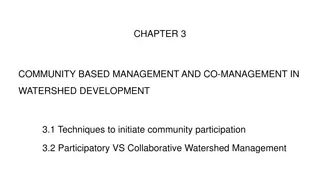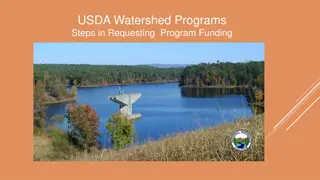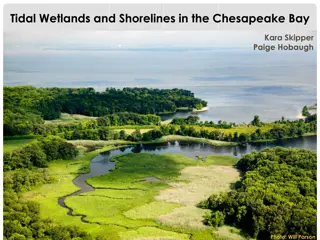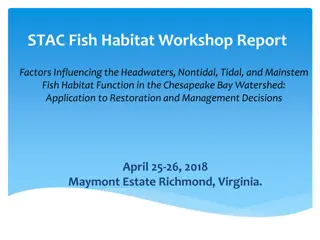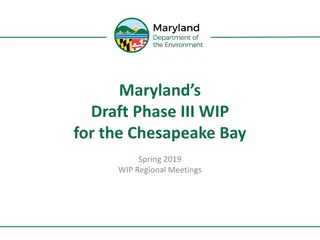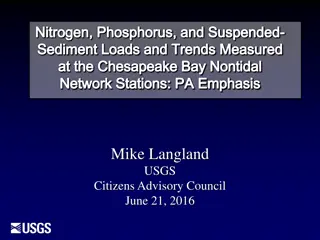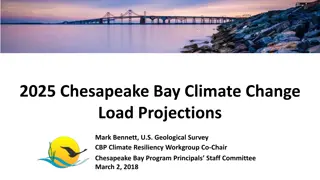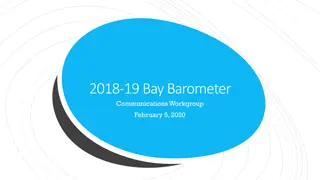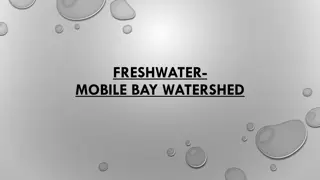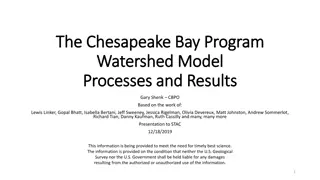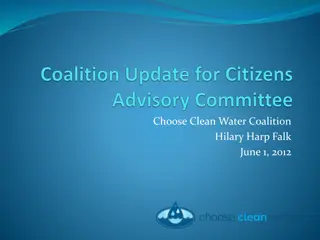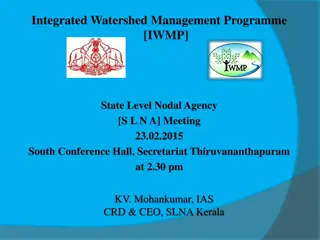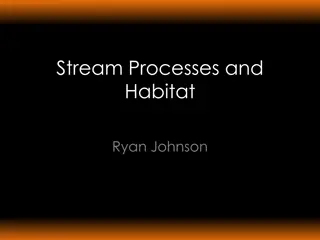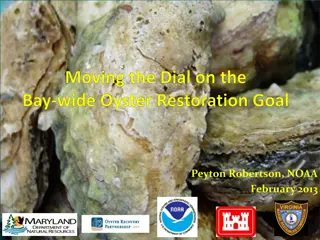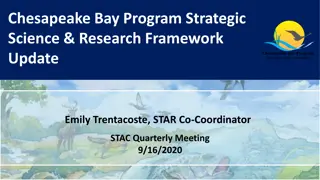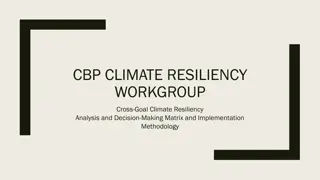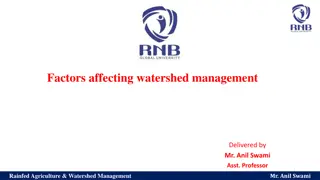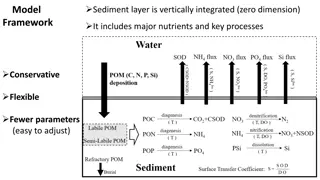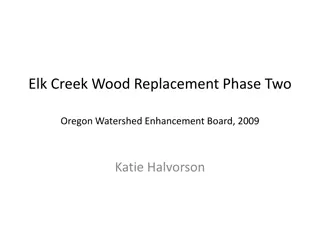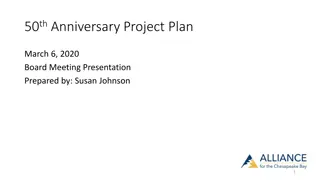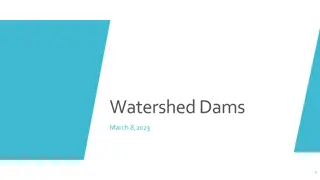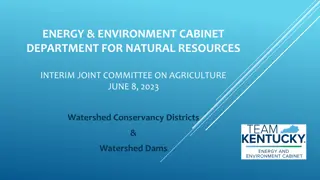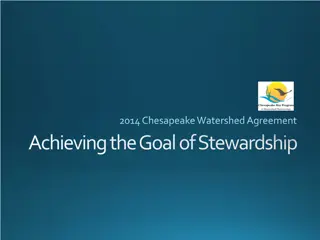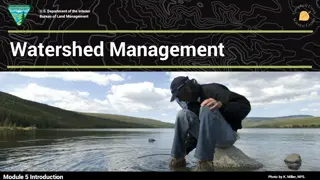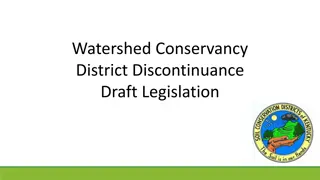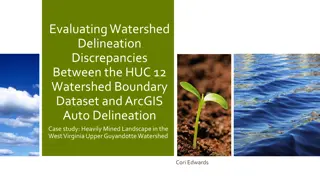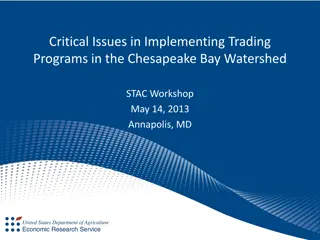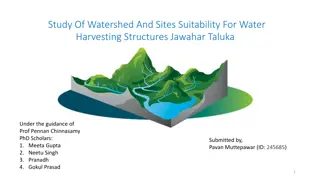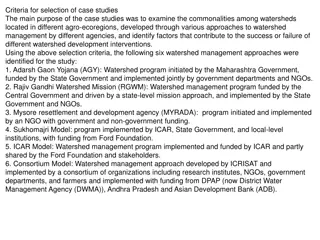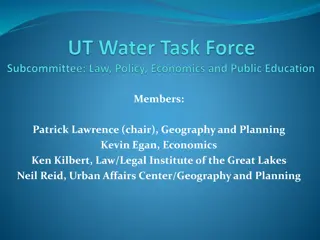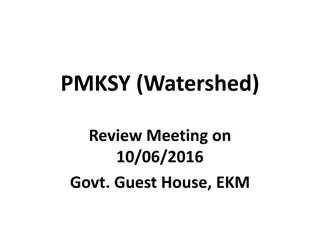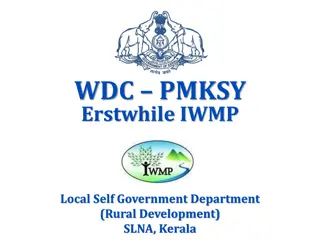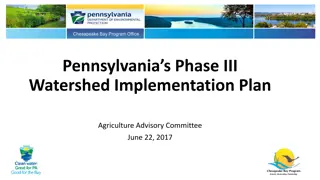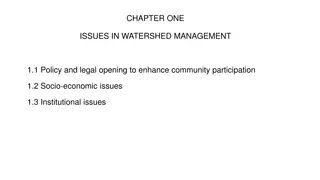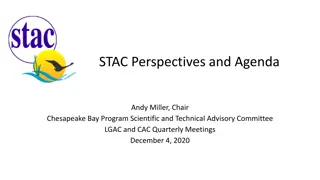Community-Based Management in Watershed Development
Techniques to initiate community participation in watershed management are crucial for sustainable development. Scholars classify participation levels into different categories, highlighting the importance of ideological motivation and voluntary engagement. The shift from direct intervention to part
0 views • 28 slides
Understanding USDA Watershed Programs for Local Communities
USDA Watershed Programs offer assistance in addressing natural resource issues such as flood control, repairing flood damages, and rehabilitating flood control dams. The three major components - Emergency Watershed Program (EWP), Watershed Protection and Flood Control Program (WPFO), and Watershed R
0 views • 15 slides
Lesner Bridge Aesthetic Lighting Program and Chesapeake Bay Necklace Lighting Schemes
This collection of images and descriptions showcases the aesthetic lighting programs for Lesner Bridge and the necklace lighting schemes on the edge of the Western Branch (WB) and Eastern Branch (EB) bridges in Chesapeake Bay. The programs include various themed lighting schemes for different events
0 views • 18 slides
Local Government Advisory Committee and Local Leadership Workgroup Collaboration
Collaboration between the Local Government Advisory Committee (LGAC) and the Local Leadership Workgroup (LLWG) focuses on engaging with local decision-makers, implementing strategies for local engagement, and supporting the flow of information among local governments in the Chesapeake Bay watershed
0 views • 10 slides
Tidal Wetlands and Shorelines in the Chesapeake Bay: Environmental Impact and Conservation Efforts
Tidal wetlands and shorelines in the Chesapeake Bay face pressures from water, land, storms, upland development, shoreline modification, and sea-level rise. Collaborative efforts like the Fish Habitat Action Team aim to highlight the importance of these ecosystems for fisheries. Projects focus on sy
0 views • 9 slides
Chesapeake Bay Climate Resiliency Workgroup Analysis & Implementation
Increase the resiliency of the Chesapeake Bay watershed against changing climate conditions. Focus on advancing climate change goals, applying climate-smart adaptation planning, and engaging in tailored conservation approaches. Specific goals include wetlands restoration and enhancement. Utilize the
0 views • 9 slides
Factors Influencing Fish Habitat in Chesapeake Bay Watershed Workshop Report
This workshop report delves into the factors affecting fish habitat function in the Chesapeake Bay Watershed, focusing on headwaters, nontidal, tidal, and mainstem areas. It outlines the workshop process, assessment frameworks, and user needs to support restoration and management decisions. The repo
1 views • 31 slides
Maryland's Draft Phase III WIP for Chesapeake Bay Spring 2019 Regional Meetings
Maryland's Phase III WIP focuses on achieving pollution reduction goals for the Chesapeake Bay by emphasizing locally-driven plans, co-benefits, and cost-effectiveness. Governor Hogan's significant investments have supported key restoration programs, with a target to reduce nitrogen levels. The stat
0 views • 19 slides
Chesapeake Bay Nontidal Monitoring Network Report
This report highlights the measurement of nitrogen, phosphorus, and suspended sediment loads at the Chesapeake Bay Nontidal Network stations, emphasizing trends and analysis conducted by various professionals. It discusses the response to restoration activities and land use changes, aiming to inform
0 views • 25 slides
Chesapeake Bay Climate Change Load Projections for 2025
The document discusses climate change projections for the Chesapeake Bay in 2025, focusing on factors like sea level rise, temperature increase, and precipitation change. It outlines proposed policy decisions, addressing uncertainties in climate change impacts on water quality and the need to incorp
0 views • 22 slides
2018-19 Bay Barometer Communications Workgroup Report
Annual report on watershed health and restoration, highlighting the lack of updated indicators and providing insights into the improved indicators concerning blue crab abundance, protected lands, public access, RPI, and SAV metrics. The report outlines the progress made in various areas within the C
0 views • 12 slides
Exploring the Freshwater Mobile Bay Watershed
The Mobile Bay Watershed covers a vast area across multiple states, with various rivers and water bodies interconnected through a network of tributaries. Major Alabama rivers, including the Mobile River and the Tombigbee River, flow through this watershed, supporting diverse ecosystems. However, env
0 views • 8 slides
Chesapeake Bay Program Watershed Model Overview
The Chesapeake Bay Program's Watershed Model, presented to STAC in December 2019, provides insights on long-term average pollutant loads and land use dynamics in the Chesapeake Bay watershed. The model incorporates inputs such as land use acres, BMPs, and delivery mechanisms to estimate pollutant lo
0 views • 41 slides
Coalition for Clean Water: Advocating for Chesapeake Bay Restoration
The Choose Clean Water Coalition, led by Hilary Harp Falk, is a diverse group of over 230 organizations working towards restoring rivers and streams in the Chesapeake region. Their mission includes coordinating policies and actions at all levels to ensure clean-up success. With a vision of vibrant,
0 views • 25 slides
Integrated Watershed Management Programme State Level Nodal Agency Meeting Report
The State Level Nodal Agency meeting for the Integrated Watershed Management Programme was held on 23rd February 2015 in Thiruvananthapuram, where various agenda items were discussed, including confirmation of previous meeting minutes, action taken reports, project approvals, and resolving project d
0 views • 54 slides
Understanding Watershed Processes and Habitat Impact
Explore the intricate relationship between stream processes, watershed factors, and habitat effects on local wildlife. Learn how climate, geology, soil, vegetation, water, and land use play crucial roles in shaping ecosystems. Discover the importance of maintaining a healthy vegetative community for
0 views • 27 slides
Oyster Restoration Efforts in Chesapeake Bay
Efforts are underway to restore oyster populations in Chesapeake Bay tributaries by 2025. Various workgroups, stakeholders, and scientists are collaborating to define restoration goals, develop tributary plans, conduct population surveys, and manage the restoration process. The Harris Creek tributar
0 views • 17 slides
Chesapeake Bay Program Decision Framework Implementation Overview
This overview provides insights into the Chesapeake Bay Program Decision Framework Implementation, including reasons for implementation, goals, steps, outcomes, and benefits. The framework emphasizes adaptive management, accountability, goal articulation, factors affecting attainment, monitoring, as
0 views • 30 slides
Chesapeake Bay Program Strategic Science & Research Framework Update
The update presented at the STAR Quarterly Meeting on 9/16/2020 outlines initiatives in environmental literacy, online science database development, and stewardship cohorts focusing on clean water goals and monitoring strategies for the Chesapeake Bay Program. The comprehensive strategies aim to imp
0 views • 10 slides
Chesapeake Bay Climate Resiliency Workgroup Analysis & Implementation
This document outlines the goals and objectives of the Chesapeake Bay Climate Resiliency Workgroup, focusing on increasing the resiliency of the watershed to changing environmental and climate conditions. It includes strategies for monitoring, assessment, adaptation, and project goals to enhance the
0 views • 9 slides
Factors Influencing Watershed Management Explained by Mr. Anil Swami
Mr. Anil Swami, an Assistant Professor specializing in Rainfed Agriculture & Watershed Management, discusses the factors affecting watershed management. These factors are categorized into watershed characteristics, climatic characteristics, land use patterns, social status, and organization. Watersh
0 views • 18 slides
Integrated Sediment Model for Nutrient Processes in Chesapeake Bay
This sediment model framework integrates major nutrients and key processes in a vertically integrated, zero-dimensional scheme. It is characterized by its conservative and flexible nature, with fewer parameters making adjustments easy. The model includes a scheme for POM remineralization and finds a
0 views • 8 slides
Elk Creek Wood Replacement Project Overview
This project, led by the Oregon Watershed Enhancement Board in 2009 and documented by Katie Halvorson, focuses on the replacement of wood structures in Elk Creek to enhance watershed function and habitat complexity for juvenile coho salmon. By addressing the lack of large wood, the initiative aims t
0 views • 20 slides
Alliance for the Chesapeake Bay 50th Anniversary Project Plan
Celebrate the 50th anniversary of the Alliance for the Chesapeake Bay by focusing on brand elevation and financial sustainability. The project plan outlines objectives, project management structure, roles, and timelines to achieve strategic priorities. Governance structures and subcommittee plans ar
0 views • 9 slides
Watershed Dams Rehabilitation Program in Kentucky
The Watershed Dams Rehabilitation Program in Kentucky aims to address the critical need for rehabilitating high hazard dams to ensure public safety and prevent economic damage. With funds allocated for grant programs and local sponsor matches, the initiative targets key priority dams identified by t
0 views • 8 slides
Watershed Conservation and Dam Rehabilitation Initiatives Overview
Explore the functions and responsibilities of Watershed Conservancy Districts in maintaining watershed dams, the funding mechanisms for dam rehabilitation projects, and the prioritized dam rehabilitation initiatives in Kentucky. Learn about the Watershed Dam Fund and its role in supporting the rehab
0 views • 8 slides
Achieving the Goal of Stewardship in the Chesapeake Watershed Agreement
The Chesapeake Watershed Agreement aims to increase the number and diversity of local citizen stewards and local governments supporting conservation and restoration activities for healthy local streams, rivers, and the Chesapeake Bay. Recognizing the importance of local involvement, citizen stewards
0 views • 8 slides
Understanding Watershed Management: Balancing Needs and Resources
Exploring the importance of watersheds in providing natural resources, the consequences of human modifications, and how communities strive to balance human needs with protecting watershed health. This module delves into the sources of community essentials like water, electricity, and heat, emphasizi
1 views • 12 slides
New Procedure for Watershed Conservancy District Discontinuance
A draft legislation proposes a new procedure for discontinuing inactive Watershed Conservancy District boards. Key points include criteria for initiating discontinuance, public notification requirements, voting procedures, and provisions for district boundaries and responsibilities. The legislation
0 views • 6 slides
Evaluating Watershed Delineation Discrepancies in West Virginia
This case study explores differences between NRCS Watershed Boundary Dataset and ArcGIS auto delineation in the Upper Guyandotte Watershed in West Virginia. The project aims to quantify discrepancies, analyze landscape characteristics, examine mining impacts, and assess the variations' effects on hy
0 views • 18 slides
Challenges and Recommendations in Implementing Trading Programs in Chesapeake Bay Watershed
Implementing trading programs in the Chesapeake Bay Watershed poses critical issues such as ensuring nonpoint source practices deliver as contracted and selecting proper baselines to affect markets. The workshop highlighted the importance of oversight and conditions for successful PS-NPS trading. Re
0 views • 12 slides
Sustainable Watershed Planning in Stevens County, Washington
The Colville River watershed, known as WRIA 59, is the focus of sustainable watershed planning in Stevens County, Washington. The planning aims to address current and future water needs while protecting and enhancing the water resources within the area. Regulations around water rights, land use, and
1 views • 19 slides
Study of Watershed and Sites Suitability for Water Harvesting in Jawhar Taluka
This project aims to address water scarcity in Jawhar Taluka by studying watershed characteristics and identifying suitable sites for water harvesting structures. The methodology includes DEM analysis using QGIS Grass, watershed delineation, stream extraction, and site suitability assessment based o
0 views • 4 slides
Analysis of Different Watershed Management Approaches in Various Agro-Ecoregions
This study examines six different watershed management approaches implemented in diverse agro-ecoregions, focusing on the commonalities, success, and failures of interventions. The case study of Adarsh Gaon Yojana (AGY) in Maharashtra highlights the principles and approach towards sustainable villag
0 views • 13 slides
Watershed Management Research Projects in Maumee Watershed
Explore five key research tasks focusing on policies, practices, and impacts concerning nutrient loading into Lake Erie from the Maumee Watershed. Projects include examining CAFOs and CAFFs, declaring the Maumee a distressed watershed, regulating nutrients on farmland, addressing residential lawn fe
0 views • 6 slides
Progress Review Meeting for PMKSY Watershed Projects - Financial Updates and Project Status Assessment
The review meeting held on 10/06/2016 at the Government Guest House in EKM discussed the financial progress and project status of PMKSY Watershed Projects in various districts including Kasargode, Kannur, Kozhikode, Malappuram, Palakkadu, and Wayanadu. The detailed analysis included the project cost
0 views • 64 slides
Watershed Development Programme in Kerala: A Comprehensive Overview
The Watershed Development Programme in Kerala underwent significant transformations over the years, evolving from the Integrated Watershed Management Programme to its current form under the Pradhan Mantri Krishi Sinchayee Yojana. The program's implementation involves various institutional mechanisms
0 views • 43 slides
Pennsylvania's Phase III Watershed Implementation Plan
Pennsylvania's Phase III Watershed Implementation Plan focuses on reducing nitrogen, phosphorus, and sediment loading to meet Chesapeake Bay Total Maximum Daily Load requirements by 2025. The plan involves various sectors like agriculture, urban runoff, and forest areas to achieve necessary reductio
0 views • 30 slides
Issues in Watershed Management: Policy, Legal, and Community Participation
Policy and legal frameworks play a crucial role in enhancing community participation in watershed management. Understanding policy impacts, participatory processes, and implementation strategies are key for effective management planning. Definitions of policy, its components, and what it is not are
0 views • 81 slides
Chesapeake Bay STAC Overview and Key Contributions
Chesapeake Bay Scientific and Technical Advisory Committee (STAC) comprises 37 volunteers from various institutions providing scientific and technical advice to the Chesapeake Bay Program. STAC members contribute time valued at over $500,000 annually, offer recommendations, and focus on technical re
0 views • 11 slides
